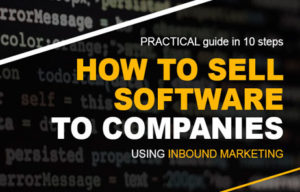If you have a Software company that markets an innovative, different and really competitive product, to find the ideal customer that will help you to buy and implement your solution in your company it might seem a simple task, right? Surely you have already discovered that it is not that easy.
Selling software to companies the competition is huge. At any niche there are tens or hundreds of competing products to address needs that are often not clearly identified by the customer, who ends up betting on large suppliers.
Knowing who are the best customers for your software is a complicated task, which requires a great commercial effort and many hours invested in marketing actions with a little payback.
Inbound marketing methodology can help you in this process. In this post we give you some keys that you should take into account to identify the potential clients of a software company if you want to maximize the results of your marketing and commercial budget.
Try to focus on
There are many companies, however, if you really want to be effective with your marketing campaigns, you have to make an effort to reduce your scope to be able to attract customer’s attention.
These are some of the filters that can be used to focus your efforts and try to get more return from your actions:
- Sectors in which you have already achieved successful implementations.
- Volume of business of the company.
- Relevance of the process of your software on your strategy.
- Possible economic impact and return on investment of your software.
- Companies with their own IT department.
- Annual investment of the company in IT.
- Growth prospects.
- Number of potential users of your software.
Establish in each case how to use the filters to guide your campaigns depends on your software and your business strategy. Consider that these criteria are not unchanging and that you will be able to make adjustments while you progress in your actions and you begin to have information about the results of your campaigns.
We sell to people, not to companies
Doubts at the time of contacting with the ideal person when you show your product within the company: is it the CTO? The CEO? The user? Inbound marketing methodology tries to get those potential customers to find you, through useful and relevant content for them in every stage of their Buyer’s Journey. That is why it is vital that you take the time to find out who is that person that you must go with throughout all its trip to your product.
Take your time, research, ask your current customers and to your salespeople. Who are these people? What problems do they have? Where are they searching? What motivates them? How do they decide?
Try to describe their Buyer’s Journey, from the moment they detect a problem or an opportunity, how they investigate possible solutions in their case and what motivates their final decision. What information could they search on Google at any time? In what networks do they participate to seek advice? What publications do they read?
In Inbound methodology, it is used the term of persona or buyer persona to refer to a semi-fictitious representation of your ideal client based on the research and actual data of your current customers, as well as certain assumptions about their behavior.
Create several people that represent your main target and always keep them in mind while developing your content and marketing messages.
The window of opportunity
In the relationship with customers it is essential to be in the right place at the right time. Devoting efforts to contact a company that is supposed to be a perfect client for your software when you have just changed all your systems is a waste of time. The same can happen if you are very aggressive with a person who has just been aware of their need, or if you are too slow with someone who has an urgent deadline to make a decision.
Inbound marketing methodology is about creating useful content for potential buyers at each moment of their Buyer’s Journey: from detecting symptoms of having a problem or need (awareness), going through the time they are able to identify that problem and it begins to know possible solutions (consideration), until it carries out an exhaustive analysis of its main alternatives to make the purchase (decision).
In this way, you will always be aligned with the client’s moment and you will increase your chances of success exponentially.
Create a process
If you use Inbound methodology, little by little you will begin to receive information from potential clients who have decided to give you their data in exchange for access to some content or offer through your website. From that moment on, it is essential that a process is started in which no potential client is left behind or forgotten (no lead left behind). This process will cause certain actions to be carried out before the client’s events, such as:
- Sending an email with relevant information and calls to action.
- Addition to a specific mailing list.
- Research on the potential client.
- Phone call.
- Contact through LinkedIn or other networks.
- Making a demo.
The objective of each of these actions must be to cause the potential customer to advance in the Buyer’s Journey in hand with our company and our software, generating a relationship of trust and usefulness that facilitates our final objective: to sell.
Implementing a process of this style can be complicated if you have a high volume of contacts, so our recommendation is that you use a marketing automation tool like HubSpot.




